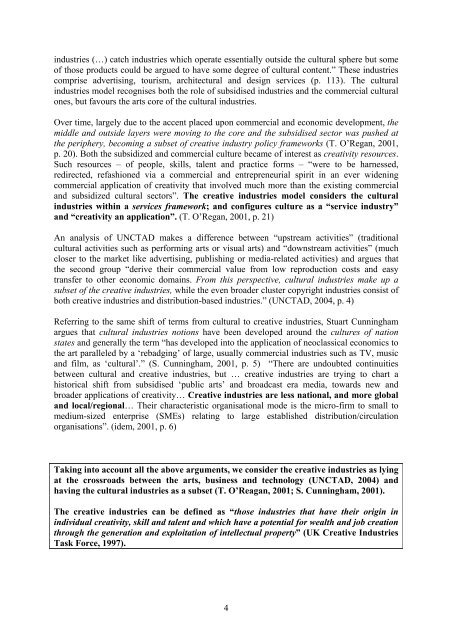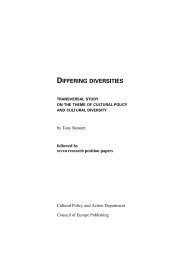Future of Creative Industries - Implications for Research ... - Europa
Future of Creative Industries - Implications for Research ... - Europa
Future of Creative Industries - Implications for Research ... - Europa
You also want an ePaper? Increase the reach of your titles
YUMPU automatically turns print PDFs into web optimized ePapers that Google loves.
industries (…) catch industries which operate essentially outside the cultural sphere but some<strong>of</strong> those products could be argued to have some degree <strong>of</strong> cultural content.” These industriescomprise advertising, tourism, architectural and design services (p. 113). The culturalindustries model recognises both the role <strong>of</strong> subsidised industries and the commercial culturalones, but favours the arts core <strong>of</strong> the cultural industries.Over time, largely due to the accent placed upon commercial and economic development, themiddle and outside layers were moving to the core and the subsidised sector was pushed atthe periphery, becoming a subset <strong>of</strong> creative industry policy frameworks (T. O’Regan, 2001,p. 20). Both the subsidized and commercial culture became <strong>of</strong> interest as creativity resources.Such resources – <strong>of</strong> people, skills, talent and practice <strong>for</strong>ms – “were to be harnessed,redirected, refashioned via a commercial and entrepreneurial spirit in an ever wideningcommercial application <strong>of</strong> creativity that involved much more than the existing commercialand subsidized cultural sectors”. The creative industries model considers the culturalindustries within a services framework; and configures culture as a “service industry”and “creativity an application”. (T. O’Regan, 2001, p. 21)An analysis <strong>of</strong> UNCTAD makes a difference between “upstream activities” (traditionalcultural activities such as per<strong>for</strong>ming arts or visual arts) and “downstream activities” (muchcloser to the market like advertising, publishing or media-related activities) and argues thatthe second group “derive their commercial value from low reproduction costs and easytransfer to other economic domains. From this perspective, cultural industries make up asubset <strong>of</strong> the creative industries, while the even broader cluster copyright industries consist <strong>of</strong>both creative industries and distribution-based industries.” (UNCTAD, 2004, p. 4)Referring to the same shift <strong>of</strong> terms from cultural to creative industries, Stuart Cunninghamargues that cultural industries notions have been developed around the cultures <strong>of</strong> nationstates and generally the term “has developed into the application <strong>of</strong> neoclassical economics tothe art paralleled by a ‘rebadging’ <strong>of</strong> large, usually commercial industries such as TV, musicand film, as ‘cultural’.” (S. Cunningham, 2001, p. 5) “There are undoubted continuitiesbetween cultural and creative industries, but … creative industries are trying to chart ahistorical shift from subsidised ‘public arts’ and broadcast era media, towards new andbroader applications <strong>of</strong> creativity… <strong>Creative</strong> industries are less national, and more globaland local/regional… Their characteristic organisational mode is the micro-firm to small tomedium-sized enterprise (SMEs) relating to large established distribution/circulationorganisations”. (idem, 2001, p. 6)Taking into account all the above arguments, we consider the creative industries as lyingat the crossroads between the arts, business and technology (UNCTAD, 2004) andhaving the cultural industries as a subset (T. O’Reagan, 2001; S. Cunningham, 2001).The creative industries can be defined as “those industries that have their origin inindividual creativity, skill and talent and which have a potential <strong>for</strong> wealth and job creationthrough the generation and exploitation <strong>of</strong> intellectual property” (UK <strong>Creative</strong> <strong>Industries</strong>Task Force, 1997).4














